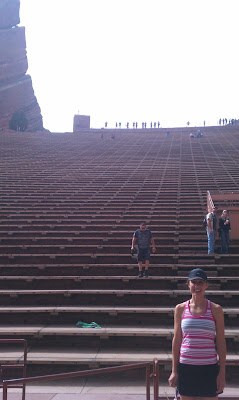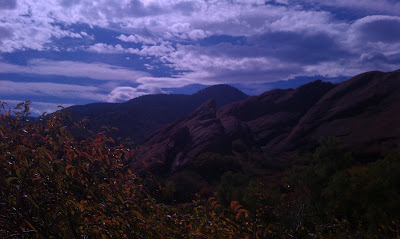I learned about open
mouth sleeping early on in Denver, "The Mile High City."
You shouldn’t do it. The
air here doesn’t hold water like the mushy, moist, dense air of Portland. Why would
it? It rarely rains and the sun is working each and every day to evaporate
those drops of H2O that may be invisibly dangling around us. So, if you sleep
for eight hours with your mouth open, your saliva, too, will evaporate. With
every breath you release, a drop of spit will jump onto an air molecule for a
ride on the wind. The air here doesn't hold much oxygen either. I looked it up. The higher you go, the more spread out the molecules are. The higher you go, the less pressure the air surrounds everything with. (That's why your shampoo bottles explode-- less molecules pushing on them to hold their shape) So in a given amount of space, there are less oxygen molecules and less water molecules than we're used to having in that same amount of space at sea level. Here are some real-life stories I'm considering submitting to the wikipedia explanation of high altitude air.
It wasn’t difficult
to slip into sleep my second night in Denver. We’d traveled over 1300 miles in
four days and I’d picked up undiagnosed symptoms of nausea I was managing with
regular gulps of Pepto Bismol. Eating and drinking were out of the question,
although I’d forced down a glass of soda water before falling asleep. Patrick
had to travel for work, so when I abruptly opened my eyes to the unfamiliar
dark room in my newly settled bungalow, there was only the rhythmic sound (and
smell) of dog breath.
As I gained focus and brought my snakeskin lips together, I sensed a smooth,
round stone in my mouth. I pushed it against the inside of my cheek, discovering it was
attached. The sensation in my cheek lining was gone and in its place, the inner
walls of a lava cave. As I banged my solid, former tongue around my mouth, from
the depths, some struggling saliva found its way into to the barren, arid cavern. Disoriented,
I stumbled to the bathroom and let the faucet run over my lips and tongue until
I could bend it again and perform the act of swallowing. My hovering
consciousness prevented me from noticing my tongue had cracked until the next
morning. The split across my taste buds would remind me for days, to sleep with
my mouth closed, saliva locked down, leaving no temptation to joy-ride the thin,
dry, mile-high air.
When Patrick returned
from his work trip, I warned him about open mouth sleeping and we took my
injured tongue and the dogs to explore Red Rocks Park and Amphitheater in
Morrison, Colorado. It’s about a thirty minute drive west of Denver. Before visiting,
the only thing I really knew about Red Rocks was that Dave Matthews Band
recorded an album there- Live at Red Rocks. That made me think it was a pretty
famous music venue and that we should see a concert there. After a little
research, I found out we missed the concert season, but that there were tons of
trails around for hiking and people liked to workout in the amphitheater.
 |
| Approaching the park. |
I was absolutely
awe-stricken at the rock formations we witnessed as we drove into the park.
When I taught fourth grade, students came to my classroom for the unit on “Changing
Earth.” I told them how earth changes through glacial movement, volcanoes, flooding,
tectonic plate shifts and more. And that different rocks form as a result of
the heat and pressure of this movement- mainly metamorphic rock, igneous rock and
sedimentary rock. We see more igneous rock in our northwest corner of the country as a
result of volcanic activity. These rocks are recognized by the little holes in
them. But near the Rockies, it’s all about sedimentary and metamorphic rocks.
The shifting tectonic plates really do a number on them. Super old rock from
millions of years ago is pushed above the surface when tectonic plates slide
into each other. You’ll know you’re looking at sedimentary rock because it’s
formed by layers of sediment piling up and you can see the horizontal lines it
creates. Check out the sedimentary specimens at Red Rock.
 |
| Notice the multi-colored layers. That's your clue your looking at sedimentary rock. |
 |
| The sedimentary layers were pushed up by the shifting of tectonic plates! COOL, huh? |
You know you’re
looking at metamorphic rock because it doesn’t look like igneous or sedimentary
and it may remind you of granite or marble. We’ve seen huge granite chunks in
people’s yards all over Denver. Amazing.
Patrick and I wanted
to check out the amphitheater before we hiked around the park with the pups. It was a quick
walk from the parking lot and we were inside the lowest seating section. Red Rocks was modeled
after a Greek structure built into a hillside that allowed 20,000 people to
hear an unamplified voice. As Patrick powered ahead I pointed out a sign that
said, “Take the stairs. Burn 40 calories.”
 |
| Lotta stairs. |
We exchanged a “why
wouldnchya?” glance and pretended not to be racing each other up the hundreds
of steps. I felt great! Donning my running shoes, I was paced to beat Patrick in
his flip flops. Lifting my legs with the swing of my arms and settling into a
stride, I thought “Damn- I’m in pretty good shape!” The burn thickened my
prance and near the top, and Patrick pulled ahead. Proud of my performance, I
found him catching his breath against a half-wall overlooking the stage, the
park, the west side of Denver. It was breath-taking.
 |
| Breath-taking view at the top of the stairs. |
Really. I couldn’t
breathe. At all. You’d have thought I’d held my breath the entire flight of
stairs. That’s what it felt like. My lungs couldn’t suck air fast or deep
enough. Nearing hyperventilation. My pride tried to control my diaphragm but
there was no hiding it. I doubled over the wall and let the spastic gasping run
its course. “The elevation really gets you,” Patrick comforted me. “Yeah,” I
laugh/sputtered, “I had no idea I wasn’t getting enough oxygen until I reached
the top.”
After we soaked in the view for a minute we wandered over to a heart rate monitor. Let me remind you, I just completed an Olympic distance triathlon in June. And I have really low blood pressure. And I had recovered for a minute from the stairs.
After we soaked in the view for a minute we wandered over to a heart rate monitor. Let me remind you, I just completed an Olympic distance triathlon in June. And I have really low blood pressure. And I had recovered for a minute from the stairs.
My heart was beating
220 beats per minute. That’s more than three beats a second. Seems impossible. Patrick clocked in
at 110. I think the machine was broken. As we finished our tour of the
amphitheater, we watched lots of really fit people popcorning around the
stadium, seemingly unaffected by the lack of oxygen in the air. I decided we
would need to come back once we’d adjusted to the altitude. And once my tongue
healed.

No comments:
Post a Comment